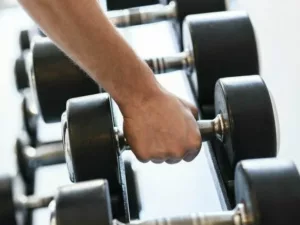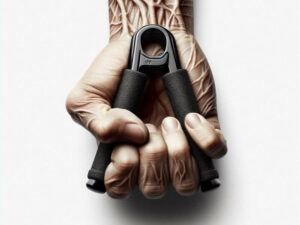(Last Updated on September 28, 2025 by Henry)
Grip is Everything
When it comes to weightlifting, grip is everything. It’s the foundation of your connection to the barbell, dumbbell, or whatever equipment you’re lifting.
A secure grip not only supports your lifting technique but also boosts your confidence as you tackle heavier weights.
Without it, you’re likely to experience the frustrating issues of sweaty palms and slipping bars, which can mess with performance and even increase injury risk.
This is where chalk steps into the spotlight. Made from magnesium carbonate, it’s a staple across gyms and competitions worldwide.
Chalk quickly dries up that annoying sweat, giving your hands a gritty feel that digs into the bar. That translates into stronger lifts and a reduced chance of slipping, allowing you to maintain consistency in your form and execution. Imagine doing a deadlift or a heavy snatch without worrying about the bar escaping your grip. That’s the freedom chalk provides.
But it’s not just about lifting heavier. Chalk can also improve safety by reducing hand slippage, which lowers your chances of an accidental drop or lift gone wrong. Many find this aspect just as crucial, if not more so, than grip improvement. Chalk is valued in styles as varied as powerlifting, Olympic lifting, and even for those dabbling in CrossFit or climbing. It’s such an integral part of these activities that it’s almost surprising to see a lifter without it.
So whether you’re stepping into a gym for the first time or preparing for your next competition, understanding the value of chalk and its role in your lifting journey can make a big difference. A few seconds spent applying chalk can pay off with more reps, better lifts, and, ultimately, greater progress in your fitness journey.
The Science of Grip and Chalk
Understanding how grip works at a scientific level can really change your approach to lifting. The concept centers around friction, which is the main force keeping your hands glued to the bar. Chalk is typically made from magnesium carbonate, and its primary job is to absorb moisture. Sweat is a grip’s worst enemy. With chalk, your hands stay dry, which seriously hikes up that friction and gives you a way firmer hold, especially during intensive lifts.
When you layer chalk over a bar that’s got knurling—those tiny, rough patterns on the metal—it creates a lock-tight connection between your hands and the bar. This combo of chalk and knurled finish turns your grip from shaky to steady and strong. Imagine trying to get through a deadlift or a set of pull-ups without that special gritty feeling. It feels more like a dance between slipping and gripping!
Chalk versus bare hands is like night and day. Take deadlifts, a classic test of grip strength. The contrast is obvious. Without chalk, sweat can make it feel like you’re fighting against the bar. With chalk, though, it’s as if that barrier isn’t there, and you’re just focused on lifting. The tension shifts from worrying about your hold to executing your lift with precision.
In weightlifting, this change in grip strength isn’t just a small upgrade. It’s a game-changer. For squats and presses, where the bar rests differently, it still makes a difference. Talk to any seasoned lifter, and they’ll tell you that chalk levels the playing field across all these lifts, no matter what stage you’re at in your lifting game. It’s about minimizing distractions and maximizing performance every time you step up to lift.
Types of Chalk and When to Use Them
Powder Chalk is the most common type you’ll come across. It’s straightforward to apply and offers good bang for your buck. You just dip your hands into a bag or bin of this fine stuff and rub it in, making sure every inch of your palms and fingers are covered. Powder chalk is versatile, but messy. Expect it to create that white cloud effect every time you clap your hands. Many gyms aren’t its biggest fans due to the cleanup it requires, but it’s hard to beat for pure efficiency.
Block Chalk comes in solid pieces, which means less mess than powder. It lasts longer, and you can break off chunks as needed, which gives you more control over how much you use. Most lifters prefer it for its tidiness and ease of transport in a small gym bag. Plus, you can scrape it against your hands to avoid wasting any, which is perfect for those who hate the powdery chaos.
Liquid Chalk is a newer option and caters to those who want the benefits without the scattered white residue. It’s got an alcohol base, meaning it dries quickly on your skin, leaving behind a thin white layer that is dust-free. Liquid chalk’s portability is unmatched, and many gyms that ban powder chalk are okay with this stuff. Just remember, it can dry your skin out, so moisturize if you’re using it often.
Specialty Chalks, such as sticky or colored variants, exist mostly in niche markets aimed at climbers or athletes looking for something more unique. They’re often marketed as performance mixes that claim superior grip; however, these offerings might just be more gimmicky than necessary for weightlifters. While they may add some flair to your grip game, the added cost might not be worth it for most people.
Chalk Alternatives: Tacky Glue, Tacky Towels & Beyond
If chalk isn’t your jam or if your gym’s got a strict no-chalk policy, don’t fret. You’ve got options. Tacky glue tops the list, especially in the world of Strongman training. It’s famous for its grip strength, particularly in events like stone lifting, where you need an extra hand to maintain control without slipping. But it’s not for everyone. Applying tacky glue takes some prep time, and getting it off afterward can be a bit of a pain.
Tacky towels offer a more user-friendly alternative. Think of them as portable sticky wipes. You can keep them in your bag and pull one out when you need. Just rub it onto your hands, and boom—you’ve got some serious extra grip action going on. They’re not exactly like chalk, but they serve a similar struggle against slippage and are convenient for those quick sessions.
Then, there are liquid grip sprays and rosin-based products. While often banned in powerlifting meets due to their enhanced gripping capabilities, in the training environment, they can be pretty useful. Liquid grip sprays dry clear and helps with a tack-like feel on the bar. Compared to rosin, commonly seen in gyms, it attracts less attention and keeps your hands ready for action.
Pros and cons-wise, these alternatives stack differently compared to regular chalk. Tacky solutions like glue and towels are sticky but can become high-maintenance. Other liquids do the trick without fuss, but if you’re quite traditional about keeping things simple, stepping outside the chalk box might take some adjustment.
How to Apply Chalk Properly
Getting the most out of your chalk requires a bit more than just a quick slap and go. For powder chalk, start by pouring a small amount into your hand. Rub it well so that every part of your palm and fingers is covered. You’re aiming for a thin, even layer rather than clumps. Avoid the dramatic clap-it-off move unless you’re cool with losing half of it in a cloud.
Block chalk needs a slightly different approach. Break off a small piece and rub it all over your palms and fingers.
The key here is to press the block against your skin, ensuring a strong layer in all the right spots, like your fingertips and between fingers, where grip slips usually begin.
Liquid chalk involves squeezing out a dime-sized amount and spreading it evenly. It dries fast, so be quick. Make sure it covers your whole grip area, especially the thumb webbing, where slips often happen. Watch out for overapplying, which can result in a gooey mess rather than a solid grip.
Whichever type you use, don’t leave the place looking like a snowstorm hit. Proper gym etiquette means keeping chalk residue off equipment and the gym floor.
Always carry your chalk in a sealed container or bag to avoid any unwanted spills and make your stuff easy to spot.
Remember that less is often more with chalk. Overdoing it is just wasteful and leaves you scraping it off bars afterward. A good rule of thumb? If you can see a white film over your hand, you’re good to go.

Store and transport your chalk in nifty containers or bags, especially if you’re using powder or blocks. Liquid chalk bottles are usually secure enough to stick straight in your gym bag for quick and hassle-free applications.
Benefits of Using Chalk in Weightlifting
Chalk does more than just improve your grip—it can transform your whole lifting experience. Whether you’re going for a personal record or maxing out during training, chalk helps cement your hold on the bar. This assurance translates into better performance and more reps without the worry of slipping mid-lift, which is crucial for any lifter chasing big numbers.
Beyond sheer grip, it’s about safety—keeping that bar firmly in your hands until you decide to let go. No one wants a bench press mishap or a barbell crash. Chalk significantly reduces the risk of accidents by ensuring your hands stay put, supporting smoother, more confident lifts from start to finish.
There’s also a mental edge to chalking up. By giving you that added grip security, chalk can heighten your confidence as you approach heavier weights. Knowing your hands won’t slip can relieve some of the psychological load, helping you focus purely on form and technique instead of worrying about losing control.
Another often-overlooked benefit is endurance. With a secure grip, you might find you can extend your training sets, especially for support grip exercises. This boost in duration supports overall strength development and grip endurance, factors that are just as important for functional strength training as they are for competitive lifting.
Chalk’s usefulness isn’t limited to the gym. It extends to activities like climbing, gymnastics, CrossFit, and calisthenics, where grip can often dictate success or failure. Whether hanging from a pull-up bar or scaling a rock face, that little layer of chalk can make a world of difference.
Potential Downsides and Risks
While chalk can be a game-changer, it isn’t without its drawbacks. One of the main issues is that it can lead to an over-reliance on gear to mask a weak grip. If you’re constantly reaching for chalk to complete standard lifts, it might be time to focus on developing your raw grip strength instead of only depending on chalk for support.
There’s the skin factor, too. Frequent chalk use can dry out your skin, leading to cracks and irritation. This is especially true with liquid chalks, which often contain alcohol. To keep your hands in good shape, consider regular moisturizing. It’s a small step that helps maintain your skin’s health and keeps it from drying out too much.
You also need to be aware of gym rules. Some places enforce a no-chalk policy, annoyed by the mess it creates. Loose chalk tends to scatter, and if you’re visiting a gym for the first time, check their guidelines. It’s always better to find out before you start marking up every barbell and machine with chalk dust.
Hygiene concerns come into play when you share chalk bowls, common in many gyms. These shared resources can become a mix of sweat, skin flakes, and viruses, potentially spreading germs. It’s always safer to bring your own chalk or ensure good hand hygiene if you’re using communal supplies.
Chalk and Different Lifts
Deadlifts greatly benefit from chalk, primarily due to the max pull advantage. This exercise places a serious demand on your grip, especially when going heavy. Using chalk helps maintain the hook grip, enhancing your stability on the lift and ensuring you don’t have to cut your session short due to sweaty palms.
In Olympic lifts like the snatch and clean and jerk, chalk’s role goes beyond the palms. Ensuring your fingers and thumb are covered helps secure your grip throughout the motion, crucial for those explosive movements. You need that chalky traction to shift the bar efficiently overhead without any mid-air mishaps.

For pull-ups and various calisthenics activities, chalk serves a double purpose: improving performance by reinforcing your grip and reducing blister formation on your hands.
Grinding out those last few reps becomes more achievable with that extra layer of protection chalk provides.
Strongman events see chalk used across the board. Whether gripping an axle bar that challenges hand size or handling heavy stones, it’s indispensable.
In events like the farmer’s carry, where the aim is to move weight over distance, chalk assures a more secure grip, contributing to endurance and control.
Chalk also plays nicely with other equipment. When combined with straps or even tape, it ensures that your grip remains uncompromised. For those lifting seriously, knowing when and how to combine these tools can give you a significant edge, allowing you to handle heavier weights with confidence.
Choosing the Right Chalk for You
Picking the right chalk boils down to your personal needs and preferences. Beginners might find powder chalk a straightforward option to start with. It’s versatile and gives a solid introduction to using grip aids, making it a good starting point for those new to lifting with accessories.
Heavy lifters often prefer block or liquid chalk due to their longevity and cleaner use. Block chalk offers more control and less mess, while liquid chalk is favored for its no-fuss, non-dusty application, ensuring that even strict gym environments remain happy.
Climbers and CrossFit enthusiasts might opt for specialty chalks tailored for varied grip needs and conditions. These niche products offer specific benefits, such as enhanced grip or moisture resistance, although they might come at a premium price point.
Gym-goers who travel or have multiple locations tend to favor liquid chalk or tacky towels for their portability and ease. These options fit comfortably in any gym bag and work well in environments that might frown upon traditional loose chalk.
An easy way to decide what works best for you is by comparing your immediate needs against the pros and cons of each type. A decision-making table can help, weighing factors such as mess, ease of use, and environmental compatibility.
Thanks for Stopping By
Have Questions?
Please Leave A Comment






